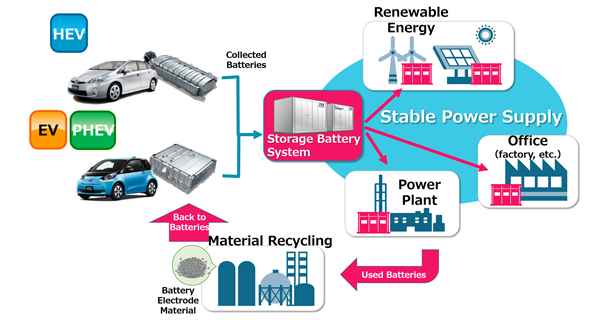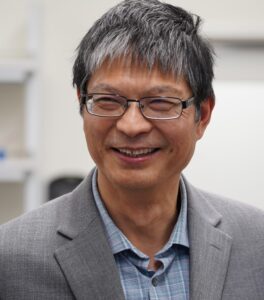Second-Life EV Batteries for Renewable and Smart Grid Storage Applications
Second-Life EV Batteries

The number of electric vehicles (EVs) on roads is growing rapidly. EV batteries today, almost exclusively lithium-ion based, can last about 10 years before they can no longer provide the required performance such as power and range. They cost heavily in both production and recycling. So economically dealing with retired EV batteries is an important topic. It is estimated that the first huge wave of EV battery retirement will hit in 2025, and more retired batteries will be available each year thereafter.
On the other hand, renewable energy, such as solar photovoltaic (PV) and wind, also enjoy a high rate of penetration. To buffer the volatile nature of the energy output of renewable energy systems, battery energy storage systems (BESSs) are frequently incorporated to balance out the variability in power generation, efficiently manage the dynamics of demand and supply, mitigate the potential failure of the grid due to over generation, provide power during a power outage, and enable cost savings by shifting the peak use and reduce demand charge. However, the high cost of new batteries in renewable and grid storage systems is a major concern for potential home and business owners.
Batteries in EVs degrade gradually over the lifetime of the vehicle and will reach the point that it is no longer able to provide the required performance, such as range and acceleration. Second-life EV batteries include not only the batteries that are discarded from EVs due to degraded conditions; but also in-warranty replacements; road accidents; test vehicle batteries; and unsold batteries. Second-life EV batteries, though no longer roadworthy in the vehicle, still have considerable capacity for renewable energy and smart grid applications where the requirement for energy and power density is not as stringent in vehicles. The use of second-life EV batteries in grid BESS extends the life cycle of batteries after their first life in EVs, improves the environment, reduces EV ownership cost by selling them for second-life use, and reduces the cost of BESS in renewable energy systems.
However, there are a number of barriers to overcome in the deployment of second-life EV batteries, including how to properly remove them from vehicles, transport, store, test, and select second-life batteries for storage applications; how to quickly, and accurately identify the battery health conditions of every cell before and after deployment in grid storage; how to dynamically manage them so as to minimize degradation and optimize usage; and how to meet various standards related to fire hazardous mitigation/prevention, certification, permit, and safety.
This talk will holistically look at these issues and address how second-life EV batteries can be used in renewable energy and smart grid applications. The talk will include storage system design, battery management, battery balancing, size optimization, and system control and optimization for demand charge management and peak shaving. We will also look at the various testing requirements for identifying the conditions of used EV batteries. The aging mechanism of second-life EV batteries will be presented. Various topologies for storage applications, safety, standard, and permit-related issues, will also be discussed.
Date and Time
Location
Hosts
Registration
-
 Add Event to Calendar
Add Event to Calendar
Speakers
 Chris Mi of San Diego State University
Chris Mi of San Diego State University
Second-Life EV Batteries for Renewable and Smart Grid Storage Applications
The number of electric vehicles (EVs) on roads is growing rapidly. EV batteries today, almost exclusively lithium-ion based, can last about 10 years before they can no longer provide the required performance such as power and range. They cost heavily in both production and recycling. So economically dealing with retired EV batteries is an important topic. It is estimated that the first huge wave of EV battery retirement will hit in 2025, and more retired batteries will be available each year thereafter.
On the other hand, renewable energy, such as solar photovoltaic (PV) and wind, also enjoy a high rate of penetration. To buffer the volatile nature of the energy output of renewable energy systems, battery energy storage systems (BESSs) are frequently incorporated to balance out the variability in power generation, efficiently manage the dynamics of demand and supply, mitigate the potential failure of the grid due to over generation, provide power during a power outage, and enable cost savings by shifting the peak use and reduce demand charge. However, the high cost of new batteries in renewable and grid storage systems is a major concern for potential home and business owners.
Batteries in EVs degrade gradually over the lifetime of the vehicle and will reach the point that it is no longer able to provide the required performance, such as range and acceleration. Second-life EV batteries include not only the batteries that are discarded from EVs due to degraded conditions; but also in-warranty replacements; road accidents; test vehicle batteries; and unsold batteries. Second-life EV batteries, though no longer roadworthy in the vehicle, still have considerable capacity for renewable energy and smart grid applications where the requirement for energy and power density is not as stringent in vehicles. The use of second-life EV batteries in grid BESS extends the life cycle of batteries after their first life in EVs, improves the environment, reduces EV ownership cost by selling them for second-life use, and reduces the cost of BESS in renewable energy systems.
However, there are a number of barriers to overcome in the deployment of second-life EV batteries, including how to properly remove them from vehicles, transport, store, test, and select second-life batteries for storage applications; how to quickly, and accurately identify the battery health conditions of every cell before and after deployment in grid storage; how to dynamically manage them so as to minimize degradation and optimize usage; and how to meet various standards related to fire hazardous mitigation/prevention, certification, permit, and safety.
This talk will holistically look at these issues and address how second-life EV batteries can be used in renewable energy and smart grid applications. The talk will include storage system design, battery management, battery balancing, size optimization, and system control and optimization for demand charge management and peak shaving. We will also look at the various testing requirements for identifying the conditions of used EV batteries. The aging mechanism of second-life EV batteries will be presented. Various topologies for storage applications, safety, standard, and permit-related issues, will also be discussed.
Biography:
Dr. Mi is the distinguished Professor of Electrical and Computer Engineering at San Diego State University. He is a Fellow of IEEE (Institute of Electrical and Electronics Engineers) and SAE (Society of Automotive Engineers). He is also the Director of the US Department of Energy-funded Graduate Automotive Technology Education (GATE) Center for Electric Drive Transportation at SDSU. He was previously a faculty member at the University of Michigan-Dearborn from 2001 to 2015, and an Electrical Engineer with General Electric from 2000 to 2001. He also served as the CTO of 1Power Solutions from 2008 to 2011 and is currently the CTO of EV Safe Charge, Inc. Dr. Mi received his Ph. D from the University of Toronto, Canada, in 2001.
Dr. Mi has published five books, 204 journal papers, 126 conference papers, and 25 issued and pending patents. He served as Editor-in-Chief, Area Editor, Guest Editor, and Associate Editor of multiple IEEE Transactions and international journals, as well as the General Chair of over ten IEEE international conferences. Dr. Mi has won numerous awards, including the “Distinguished Teaching Award” and “Distinguished Research Award” from the University of Michigan-Dearborn, IEEE Region 4 “Outstanding Engineer Award,” IEEE Southeastern Michigan Section “Outstanding Professional Award,” and SAE “Environmental Excellence in Transportation (E2T) Award.” He is the recipient of three Best Paper Awards from IEEE Transactions on Power Electronics and the 2017 ECCE Student Demonstration Award. In 2019, he received the Inaugural IEEE Power Electronics Emerging Technology Award. In 2022, he received the Albert W. Johnson Research Lectureship and named the Distinguished Professor, the highest honor given to a SDSU faculty member and only one award is given each year.
Dr. Mi was the Chair (2008-2009) and Vice-Chair (2006-2007) of the IEEE Southeastern Michigan Section. Dr. Mi was the General Chair of the 5th IEEE Vehicle Power and Propulsion Conference, Area Editor of IEEE Transactions on Vehicular Technology, associate editor of IEEE Transactions on Power Electronics, Associate Editor of IEEE Transactions on Industry Applications. He is the topic chair for the 2011 IEEE International Future Energy Challenge and the General Chair for the 2013 IEEE International Future Energy Challenge. Dr. Chris Mi is a Distinguished Lecturer (DL) of the IEEE Vehicular Technology Society.
He is Guest Editor-in-Chief of IEEE Journal of Emerging and Selected Topics in Power Electronics - Special Issue on WPT, Guest Co-Editor-in-Chief of IEEE Transactions on Power Electronics Special Issue on WPT, Guest Editor of IEEE Transactions on Industrial Electronics - Special Issue on dynamic wireless power transfer, and steering committee member of the IEEE Transportation Electrification Conference (ITEC- Asian). He is Program Chair or General Chair of a number of international conferences, including Workshop on Wireless Power Transfer (WoW), IEEE International Electric Vehicle Conference (IEVC), and IEEE International Transportation Electrification Conference – Asia-Pacific. He is the Guest Editor of a Special Issue of the Proceedings of the IEEE - Electric and Hybrid Vehicles.
Email:
Address:San Diego
Agenda
6 pm - Introductions, pizza, salad, coffee, soda pop, social interactions (you can arrive earlier if you like)
6:30 pm - Actual Talk
7:30 pm - Q&A, open discussion
8:00 pm - Formal thanks and event end
Pizza, salad & beverage will be provided
Media
| VTS Talk - 2nd life of EV batteries FLYER | VTS Talk - 2nd life of EV batteries FLYER | 357.14 KiB |

